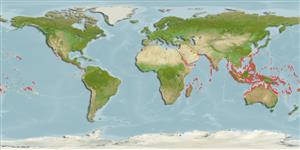>
Eupercaria/misc (Various families in series Eupercaria) >
Scaridae (Parrotfishes) > Scarinae
Etymology: Scarus: Greek, skaros = a fish described by anciente writers as a parrot fish; 1601 (Ref. 45335).
More on author: Forsskål.
Environment: milieu / climate zone / kisaran kedalaman / distribution range
Ekologi
laut berasosiasi dengan karang; kisaran kedalaman 0 - 30 m (Ref. 128797). Tropical; 30°N - 27°S
Indo-Pacific: Red Sea south to Sodwana Bay, South Africa (Ref. 5490) and east to the Society Islands, north to the Ryukyu Islands, south to Shark Bay, Western Australia and the southern Great Barrier Reef.
Size / Weight / umur
Kematangan: Lm ? range ? - ? cm
Max length : 44.4 cm TL jantan/; (Ref. 125599); Berat maksimum terpublikasi: 2.0 kg (Ref. 125599)
Duri punggung (Keseluruhan (total)) : 9; duri punggung lunak (Keseluruhan (total)) : 10; Duri dubur: 3; Sirip dubur lunak: 9. This species is distinguished by the following characters: median predorsal scales 6-8 (usually 7); 3 scale rows on cheek, 1(6-7), 2(6-9), 3(2-5); pectoral-fin rays 13-15 (usually 14); conical teeth on side, none in female, usually 2 on upper dental plate for terminal male; lips mainly covering dental plates; caudal fin rounded in small female, with prolonged lobes in large adult. Colour of male reddish brown anteriorly with red upper lip and dark bands around the mouth, greenish posteriorly with dark scale margins, the markings in the head variable but always with a dark-edged yellowish or bright green dot or spot at top end of line from mouth through eye to top of opercular opening.; female red on head, belly and fins, side with wavy black and white stripes, and dark green bands around mouth and eye (Ref. 9793, 90102).
Body shape (shape guide): fusiform / normal; Cross section: compressed.
Inhabits coral-rich areas of clear lagoons, channels, and outer reef slopes (Ref. 9710). Generally solitary (Ref. 1602). Juveniles in small groups on algae and coral reefs inshore (Ref. 48636). Feeds on benthic algae (Ref. 30573). Males maintain small harems and pair spawn (Ref. 1602).
Life cycle and mating behavior
Kematangan | Reproduksi, perkembang biakan | Pemijahan | telur-telur | Fecundity | Larva
Oviparous, distinct pairing during breeding (Ref. 205).
Randall, J.E., G.R. Allen and R.C. Steene, 1990. Fishes of the Great Barrier Reef and Coral Sea. University of Hawaii Press, Honolulu, Hawaii. 506 p. (Ref. 2334)
Status IUCN Red List (Ref. 130435: Version 2025-1)
ancaman kepada manusia
Harmless
penggunaan manusia
Perikanan: komersial; Akuarium: Komersial
Alat, peralatan
laporan khas
muat turun XML
Sumber internet
Estimates based on models
Preferred temperature (Acuan
123201): 24.9 - 29.3, mean 28.3 °C (based on 3475 cells).
Phylogenetic diversity index (Acuan
82804): PD
50 = 0.5000 [Uniqueness, from 0.5 = low to 2.0 = high].
Bayesian length-weight: a=0.01549 (0.01269 - 0.01890), b=3.04 (3.00 - 3.08), in cm total length, based on LWR estimates for this species (Ref.
93245).
Trophic level (Acuan
69278): 2.0 ±0.0 se; based on diet studies.
Daya lenting (Acuan
120179): Tinggi, Waktu penggandaan populasi minimum kurang dari 15 bulan (K=0.37-0.72).
Fishing Vulnerability (Ref.
59153): Low vulnerability (23 of 100).
🛈
Nutrients (Ref.
124155): Calcium = 44.9 [29.2, 75.5] mg/100g; Iron = 0.832 [0.586, 1.273] mg/100g; Protein = 18.7 [16.6, 20.5] %; Omega3 = 0.0871 [, ] g/100g; Selenium = 19.2 [12.1, 30.0] μg/100g; VitaminA = 40.2 [12.3, 137.2] μg/100g; Zinc = 2.26 [1.71, 2.95] mg/100g (wet weight); based on
nutrient studies.
